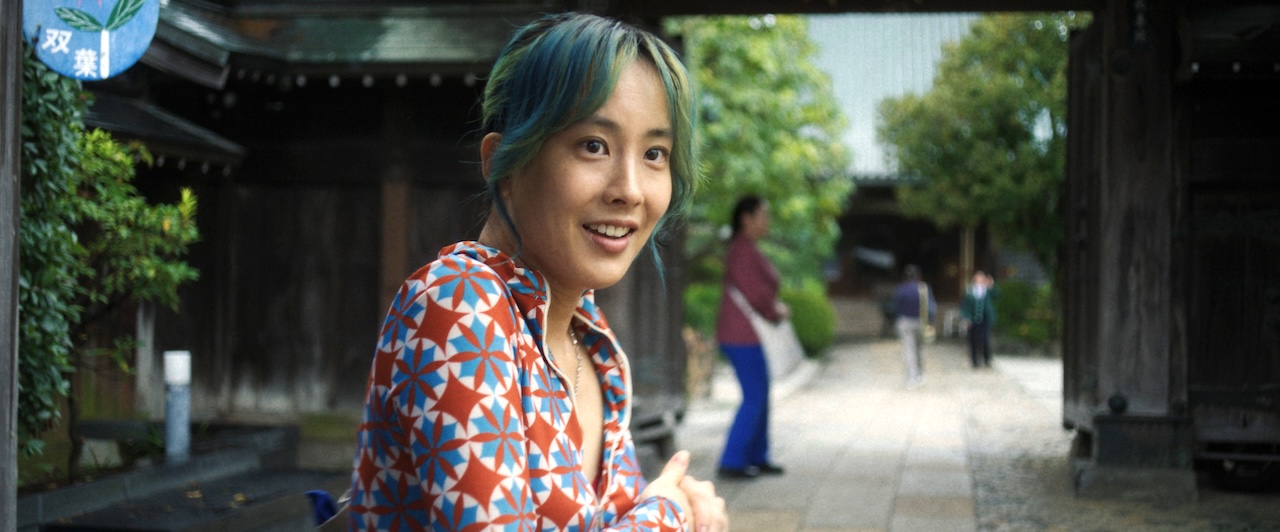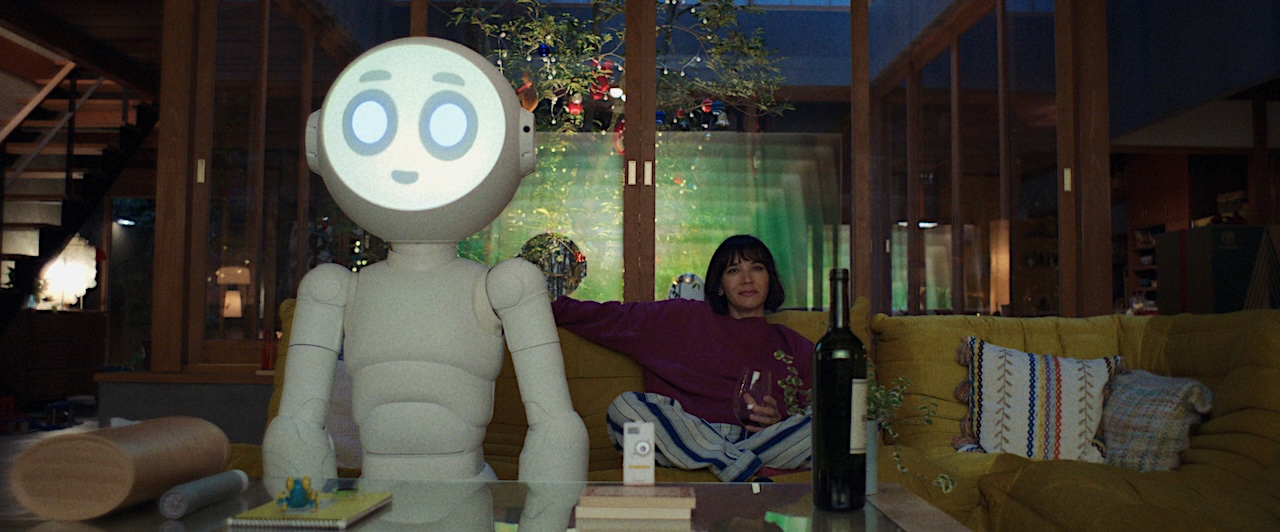AI may have increasingly become a topic of controversial debate in recent years, but its thematic presence in film and television has a long history. Still, as gadgets, gizmos and robots that once seemed futuristic and unlikely to ever manifest creep ever closer to reality, the genre lines between sci-fi and horror become just a little more blurred. And scripts become even more creative.
When showrunner Katie Robbins (The Affair, The Last Tycoon) read Colin O’Sullivan’s 2018 novel The Dark Manual, she saw the potential to explore a theme of female friendship within the context of science fiction. Joining forces with director Lucy Tcherniak (The End of the F***ing World, Station Eleven), the end result is Sunny, a dark comedy about a grieving woman, Suzie (played by Rashida Jones) who unexpectedly bonds with the home robot (Sunny) left to her by a husband she realizes she knew very little about.
Set in Japan (which was an absolute must and the country itself is a character in the story, according to both Robbins and Tcherniak), Sunny is a fresh look at the world (and potential) of AI. Comforting or disconcerting, it’s a reality we all have to face. Robbins and Tcherniak discussed why in a recent interview with Creative Screenwriting Magazine.

Lucy Tcherniak & Katie Robbins
Tell me about Colin O’Sullivan’s book and what made you want to adapt it into a series.
Katie: Colin O’Sullivan’s beautiful novel The Dark Manual came across my desk in late 2018, early 2019. I’d never written anything vaguely science fiction-adjacent. I enjoy it as a consumer, but it wasn’t something that I’d felt was the right genre for me to express myself through.
But within this book, was the kernel of a story and a character that I was really attracted to in Suzie Sakamoto. When we first meet her, she has experienced the most profound loss, that of her husband and son. She is a person for whom tragedy makes her turn inward, and she’s created a sort of emotional armor of this dark sense of humor and sarcasm; it’s a way of keeping people at bay because to let them in makes her too vulnerable. That was something that I really related to, in my own experiences of grief and hard times. I’ve tried to keep people at bay because it is overwhelming.
In the book, Sunny is a male robot and is Suzie’s adversary. I thought, “What if you turn that on its head and Sunny is a female robot brought to Suzie?” Simultaneous to that, I was doing some research into a field of robotics called HRI, or Human-Robot Interaction, which looks at the ways that robots can potentially have an emotional impact on us. And that when people are in times of grief or depression or dementia, and it can become hard to open up to other people, robots are a safer entity to connect with.
We know that they’re not going to break up with us or walk out the door, or die – they are just there. They’re not going to hurt our feelings, and so we can open up to them in ways that we can’t with people. And then slowly, in theory, you get back into the habit of opening up and connecting, and then you can connect back with people.
I thought that was a really fascinating idea and could create an arc for a female friendship – which was also a theme I had been wanting to find a way of writing – but within the shape of this science fiction world. It also has a propulsive mystery thriller element through which I could explore some deeper themes.
AI stories often have a cautionary element to them. Where does Sunny land in regards to any kind of social statement, if at all?
Katie: Sunny, as a character, is sort of emblematic of where we are with AI at the moment… which I think is that, like all things that people create, it has the potential to be really beautiful. Like music or art or poetry. There is something extraordinary about it, because it comes from us. Like with any new technology, it has the potential to do good. And like all things that people create, it has the potential to do really dark things. I think that we are in this moment as a species, at a pressure point for what is going to happen with AI. We know that AI is not going to go anywhere, right? It’s here for good now. So we have to decide how we’re going to use it and what kind of restrictions we’re going to put on it, in what ways we’re going to let it flower and make our lives better. I think Sunny represents that – in one moment, she is adorable and charming and answers Suzie’s needs. And in the next moment, we’re not so sure about what her motivations are. I think that represents this tension we’re all living in this moment.
What was it like to write a character arc for an AI… and Lucy, to then film with one on set?
Katie: I was really interested in finding a way to talk about female friendships. My life is busy with work and family, and I miss my female friends so much. So I really wanted to write about that, and I thought a lot about my own female friendships and the ways in which we meld and take on each other’s characteristics. The closer you become to someone, the more you take in their “stuff.” Lucy and I spent so much time together on set, I started speaking with a British accent by the end of it! And then my daughter started speaking with a British accent… and everyone was like “What is happening? Who are you?” I think that that just happens. So I really thought about Sunny’s arc as that of a person who has just become really smitten with Suzie. And then when another character, Mixxy, comes in, there is a sort of female friendship love triangle among the three of them. That was loosely inspired by the dynamic in the film The Favorite… and the way things get a bit messy when you want to be a person’s favorite friend. It was a lot like writing a human.

Annie The Clumsy (Mix) Photo courtesy of Apple TV+
Lucy: It was certainly the first time any of us, apart from the robotics team, had shot with a robot. It was a bit of a learning curve, but it was a pretty incredible experience. We worked very closely with Weta Workshop in designing the robot that is Sunny, an animatronic puppet robot, played by Joanna Sotomura. She was on set every single day, just off camera, with this head gear on. The technology was a little bit like “motion capture meets Apple Memoji”, where every time she expressed or spoke, that expression and her voice was then translated in real time onto the robot’s projected face. Someone else was doing the arms and someone else was driving her, and a whole team of people were checking that all of those things were working as they should in concert with one another. It was a pretty crazy experience and no one had ever used this technology before in this way, but it felt like exactly the right thing to do. It was the central relationship of the show and we didn’t want Rashida or any of the other actors in scenes with Sunny to just be working opposite a tennis ball. I think that would have really given a very different feel to the whole thing, and this show is about robots trying to help us find our humanity. It felt really important that Sunny not look human, but have that kind of quality and spirit.
The show is described as a “darkly comedic drama” – tell me about striking that tone and balancing the three elements.
Lucy: It’s something that I think we both gravitate towards – stuff that doesn’t quite fit into a neat genre box. That tone is so baked into Katie’s writing, and I think it comes from a place we both are drawn to because we’ve experienced strange, absurd comic moments that undercut tragedy and sincerity in our own lives. Life doesn’t fit into a genre box, and it’s a really hard needle to thread, but it also feels representative of real life… with a slightly stylized tone to it. It’s just about crafting those moments – maybe shining a light a little bit more precisely on the tragedy and then undercutting it quite quickly with something comedic to find that darkly comedic, slightly playful tone. Whether it’s a line of dialogue or a music choice or a whip pan when you’re not expecting it to keep the audience on their toes… there are lots of little mini choices along the way that hopefully give that tone.
We spoke about the prominent theme of female friendships in the story. Tell me about your creative partnership and how you found each other for this project.
Katie: We hadn’t worked together prior to this experience, and we have now worked together for what feels like all of our lives! When I was writing the format and initial outlines and setting the show up with A24, one of the initial tonal comps that I kept coming back to and talking about was The End of the F***ing World… and they said, “If you love The End of the F***ing World, we should send this to this brilliant human, Lucy Tcherniak.” We had our first meeting and Lucy created a playlist of 60s and 70s Japanese pop as part of her vision for what the show could be. I listened to this playlist and fell madly in love with both it and her. It has just been a tremendous partnership that I’ve never quite experienced before; it’s really an extraordinary thing to collaborate with somebody who takes ideas that you have and makes them better and more beautiful and challenges them and expands on them. It’s miraculous and amazing to write a show about female friendship and unexpectedly find a lifetime female friend. It’s been the great gift of making this.
Lucy: Ditto. I feel so lucky. I loved making this show and I’m really proud of it. But truly, becoming friends with Katie was such a huge joy of it. It has been a really fruitful collaboration that’s also been really good fun. When there was an idea, we would constantly be passing the baton between us; Katie would write an episode or a scene and I’d read it and have an idea, and she’d run away with that idea… there’s just so much trust and respect between us that it was just a really positive experience.

